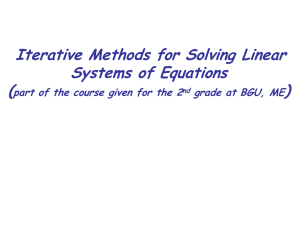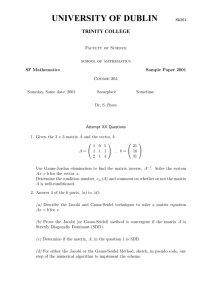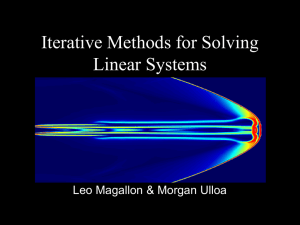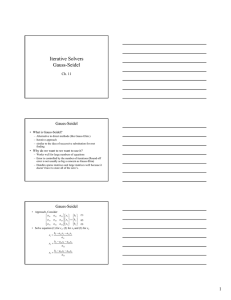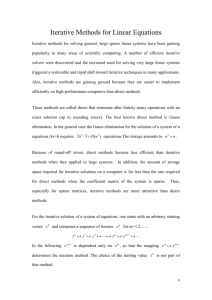Chapter 5 Iterative Methods for Solving Linear Systems
advertisement
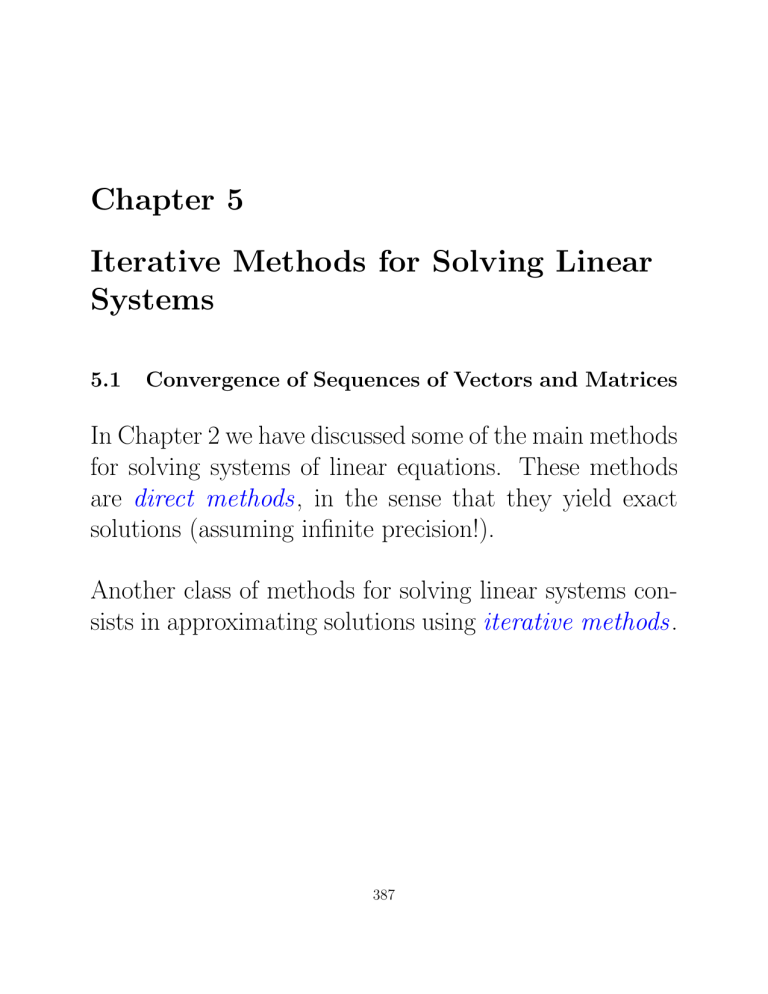
Chapter 5 Iterative Methods for Solving Linear Systems 5.1 Convergence of Sequences of Vectors and Matrices In Chapter 2 we have discussed some of the main methods for solving systems of linear equations. These methods are direct methods, in the sense that they yield exact solutions (assuming infinite precision!). Another class of methods for solving linear systems consists in approximating solutions using iterative methods. 387 388 CHAPTER 5. ITERATIVE METHODS FOR SOLVING LINEAR SYSTEMS The basic idea is this: Given a linear system Ax = b (with A a square invertible matrix), find another matrix B and a vector c, such that 1. The matrix I B is invertible 2. The unique solution x e of the system Ax = b is identical to the unique solution u e of the system u = Bu + c, and then, starting from any vector u0, compute the sequence (uk ) given by uk+1 = Buk + c, k 2 N. Under certain conditions (to be clarified soon), the sequence (uk ) converges to a limit u e which is the unique solution of u = Bu + c, and thus of Ax = b. 5.1. CONVERGENCE OF SEQUENCES OF VECTORS AND MATRICES 389 Let (E, k k) be a normed vector space. Recall that a sequence (uk ) of vectors uk 2 E converges to a limit u 2 E, if for every ✏ > 0, there some natural number N such that kuk uk ✏, for all k N. We write u = lim uk . k7!1 If E is a finite-dimensional vector space and dim(E) = n, we know from Theorem 4.3 that any two norms are equivalent, and if we choose the norm k k1, we see that the convergence of the sequence of vectors uk is equivalent to the convergence of the n sequences of scalars formed by the components of these vectors (over any basis). 390 CHAPTER 5. ITERATIVE METHODS FOR SOLVING LINEAR SYSTEMS The same property applies to the finite-dimensional vector space Mm,n(K) of m ⇥ n matrices (with K = R or K = C), which means that the convergence of a sequence (k) of matrices Ak = (aij ) is equivalent to the convergence (k) of the m ⇥ n sequences of scalars (aij ), with i, j fixed (1 i m, 1 j n). The first theorem below gives a necessary and sufficient condition for the sequence (B k ) of powers of a matrix B to converge to the zero matrix. Recall that the spectral radius ⇢(B) of a matrix B is the maximum of the moduli | i| of the eigenvalues of B. 5.1. CONVERGENCE OF SEQUENCES OF VECTORS AND MATRICES 391 Theorem 5.1. For any square matrix B, the following conditions are equivalent: (1) limk7!1 B k = 0, (2) limk7!1 B k v = 0, for all vectors v, (3) ⇢(B) < 1, (4) kBk < 1, for some subordinate matrix norm k k. The following proposition is needed to study the rate of convergence of iterative methods. Proposition 5.2. For every square matrix B and every matrix norm k k, we have lim kB k k1/k = ⇢(B). k7!1 We now apply the above results to the convergence of iterative methods. 392 5.2 CHAPTER 5. ITERATIVE METHODS FOR SOLVING LINEAR SYSTEMS Convergence of Iterative Methods Recall that iterative methods for solving a linear system Ax = b (with A invertible) consists in finding some matrix B and some vector c, such that I B is invertible, and the unique solution x e of Ax = b is equal to the unique solution u e of u = Bu + c. Then, starting from any vector u0, compute the sequence (uk ) given by uk+1 = Buk + c, k 2 N, and say that the iterative method is convergent i↵ lim uk = u e, k7!1 for every initial vector u0. 5.2. CONVERGENCE OF ITERATIVE METHODS 393 Here is a fundamental criterion for the convergence of any iterative methods based on a matrix B, called the matrix of the iterative method . Theorem 5.3. Given a system u = Bu + c as above, where I B is invertible, the following statements are equivalent: (1) The iterative method is convergent. (2) ⇢(B) < 1. (3) kBk < 1, for some subordinate matrix norm k k. The next proposition is needed to compare the rate of convergence of iterative methods. It shows that asymptotically, the error vector ek = B k e0 behaves at worst like (⇢(B))k . 394 CHAPTER 5. ITERATIVE METHODS FOR SOLVING LINEAR SYSTEMS Proposition 5.4. Let k k be any vector norm, let B be a matrix such that I B is invertible, and let u e be the unique solution of u = Bu + c. (1) If (uk ) is any sequence defined iteratively by uk+1 = Buk + c, then lim k7!1 sup ku0 u ek=1 kuk k 2 N, u ek1/k = ⇢(B). 5.2. CONVERGENCE OF ITERATIVE METHODS 395 (2) Let B1 and B2 be two matrices such that I B1 and I B2 are invertibe, assume that both u = B1u+c1 and u = B2u + c2 have the same unique solution u e, and consider any two sequences (uk ) and (vk ) defined inductively by uk+1 = B1uk + c1 vk+1 = B2vk + c2, with u0 = v0. If ⇢(B1) < ⇢(B2), then for any ✏ > 0, there is some integer N (✏), such that for all k N (✏), we have 1/k kvk u ek ⇢(B2) . sup u ek ⇢(B1) + ✏ ku0 u ek=1 kuk In light of the above, we see that when we investigate new iterative methods, we have to deal with the following two problems: 1. Given an iterative method with matrix B, determine whether the method is convergent. This involves determining whether ⇢(B) < 1, or equivalently whether there is a subordinate matrix norm such that kBk < 1. 396 CHAPTER 5. ITERATIVE METHODS FOR SOLVING LINEAR SYSTEMS By Proposition 4.8, this implies that I B is invertible (since k Bk = kBk, Proposition 4.8 applies). 2. Given two convergent iterative methods, compare them. The iterative method which is faster is that whose matrix has the smaller spectral radius. We now discuss three iterative methods for solving linear systems: 1. Jacobi’s method 2. Gauss-Seidel’s method 3. The relaxation method. 5.3. METHODS OF JACOBI, GAUSS-SEIDEL, AND RELAXATION 5.3 397 Description of the Methods of Jacobi, Gauss-Seidel, and Relaxation The methods described in this section are instances of the following scheme: Given a linear system Ax = b, with A invertible, suppose we can write A in the form A=M N, with M invertible, and “easy to invert,” which means that M is close to being a diagonal or a triangular matrix (perhaps by blocks). Then, Au = b is equivalent to M u = N u + b, that is, u=M 1 Nu + M 1 b. Therefore, we are in the situation described in the previous sections with B = M 1N and c = M 1b. 398 CHAPTER 5. ITERATIVE METHODS FOR SOLVING LINEAR SYSTEMS In fact, since A = M B=M 1 N , we have N =M which shows that I 1 A) = I (M B=M 1 M 1 A, A is invertible. The iterative method associated with the matrix B = M 1N is given by uk+1 = M 1 N uk + M 1 b, k 0, starting from any arbitrary vector u0. From a practical point of view, we do not invert M , and instead we solve iteratively the systems M uk+1 = N uk + b, k 0. 5.3. METHODS OF JACOBI, GAUSS-SEIDEL, AND RELAXATION 399 Various methods correspond to various ways of choosing M and N from A. The first two methods choose M and N as disjoint submatrices of A, but the relaxation method allows some overlapping of M and N . To describe the various choices of M and N , it is convenient to write A in terms of three submatrices D, E, F , as A=D E F, where the only nonzero entries in D are the diagonal entries in A, the only nonzero entries in E are entries in A below the the diagonal, and the only nonzero entries in F are entries in A above the diagonal. 400 CHAPTER 5. ITERATIVE METHODS FOR SOLVING LINEAR SYSTEMS More explicitly, if 0 a11 a21 a31 .. a12 a22 a32 .. a13 a23 a33 .. ··· ··· ··· ... a1n a2n a3n .. 1 a1n a2n a3n .. 1 B C B C 1 B C B C 1 B C A=B C, B C B C Ba C a a · · · a a n 1 1 n 1 2 n 1 3 n 1 n 1 n 1 n @ A an 1 an 2 an 3 · · · an n 1 an n then 0 a11 B B0 B B0 B D=B . B . B B0 @ 0 0 a22 0 .. 0 0 0 0 a33 .. 0 0 ··· ··· ··· ... 1 0 0 0 .. · · · an 1 n ··· 0 1 0 C 0 C C 0 C C , .. C C C 0 C A an n 5.3. METHODS OF JACOBI, GAUSS-SEIDEL, AND RELAXATION 0 0 a21 a31 .. 0 0 a32 .. 0 0 0 ... ··· ··· ··· ... ... a12 0 0 .. 0 0 a13 a23 0 .. 0 0 · · · a1n 1 · · · a2n 1 . . . a3n 1 ... ... ··· ··· 0 0 1 0 0 0 .. 0 B B B B B E=B B B Ba @ n 1 1 an 1 2 an 1 3 an 1 an 2 an 3 · · · an n 0 0 B B0 B B0 B F = B. B. B B0 @ 0 401 a1n a2n a3n .. 1 0 C 0C C 0C C , .. C C C 0C A 0 1 C C C C C C. C C an 1 n C A 0 402 CHAPTER 5. ITERATIVE METHODS FOR SOLVING LINEAR SYSTEMS In Jacobi’s method , we assume that all diagonal entries in A are nonzero, and we pick M =D N = E + F, so that B=M 1 N = D 1(E + F ) = I D 1A. As a matter of notation, we let J =I D 1A = D 1(E + F ), which is called Jacobi’s matrix . 5.3. METHODS OF JACOBI, GAUSS-SEIDEL, AND RELAXATION 403 The corresponding method, Jacobi’s iterative method , computes the sequence (uk ) using the recurrence uk+1 = D 1(E + F )uk + D 1b, k 0. In practice, we iteratively solve the systems Duk+1 = (E + F )uk + b, k 0. If we write uk = (uk1 , . . . , ukn), we solve iteratively the following system: a11 uk+1 1 a22 uk+1 2 .. . = = .. . an 1 n 1 uk+1 n 1 = an n uk+1 = n a21 uk1 .. . an 1 1 uk1 an 1 uk1 a12 uk2 ··· an 2 uk2 a13 uk3 a23 uk3 an k 1 n 2 un 2 ··· ··· ··· a1n ukn a2n ukn . an an n 1 ukn 1 + b1 + b2 k 1 n un + bn + bn 1 Observe that we can try to “speed up” the method by using the new value uk+1 instead of uk1 in solving for 1 uk+2 using the second equations, and more generally, use 2 k+1 k+1 k k uk+1 1 , . . . , ui 1 instead of u1 , . . . , ui 1 in solving for ui in the ith equation. 404 CHAPTER 5. ITERATIVE METHODS FOR SOLVING LINEAR SYSTEMS This observation leads to the system a11 uk+1 1 a22 uk+1 2 .. . = = .. . an 1 n 1 uk+1 n 1 = an n uk+1 = n a12 uk2 a21 uk+1 1 a13 uk3 a23 uk3 .. . an 1 1 uk+1 1 an 1 uk+1 1 ··· an 2 uk+1 2 an k+1 1 n 2 un 2 ··· a1n ukn a2n ukn ··· ··· an an n 1 uk+1 n 1 k 1 n un + b1 + b2 + bn 1 + bn , which, in matrix form, is written Duk+1 = Euk+1 + F uk + b. Because D is invertible and E is lower triangular, the matrix D E is invertible, so the above equation is equivalent to uk+1 = (D E) 1F uk + (D E) 1b, k 0. The above corresponds to choosing M and N to be M =D N = F, E and the matrix B is given by B=M 1 N = (D E) 1F. 5.3. METHODS OF JACOBI, GAUSS-SEIDEL, AND RELAXATION Since M = D E is invertible, we know that I M 1A is also invertible. 405 B= The method that we just described is the iterative method of Gauss-Seidel , and the matrix B is called the matrix of Gauss-Seidel and denoted by L1, with L1 = (D E) 1F. One of the advantages of the method of Gauss-Seidel is that is requires only half of the memory used by Jacobi’s method, since we only need k+1 k k uk+1 1 , . . . , ui 1 , ui+1 , . . . , un to compute uk+1 i . We also show that in certain important cases (for example, if A is a tridiagonal matrix), the method of GaussSeidel converges faster than Jacobi’s method (in this case, they both converge or diverge simultaneously). 406 CHAPTER 5. ITERATIVE METHODS FOR SOLVING LINEAR SYSTEMS The new ingredient in the relaxation method is to incorporate part of the matrix D into N : we define M and N by D M= E ! 1 ! N= D + F, ! where ! 6= 0 is a real parameter to be suitably chosen. Actually, we show in Section 5.4 that for the relaxation method to converge, we must have ! 2 (0, 2). Note that the case ! = 1 corresponds to the method of Gauss-Seidel. If we assume that all diagonal entries of D are nonzero, the matrix M is invertible. 5.3. METHODS OF JACOBI, GAUSS-SEIDEL, AND RELAXATION 407 The matrix B is denoted by L! and called the matrix of relaxation, with ✓ ◆ 1✓ ◆ 1 ! D E D+F ! ! = (D !E) 1((1 !)D + !F ). L! = The number ! is called the parameter of relaxation. When ! > 1, the relaxation method is known as successive overrelaxation, abbreviated as SOR. At first glance, the relaxation matrix L! seems at lot more complicated than the Gauss-Seidel matrix L1, but the iterative system associated with the relaxation method is very similar to the method of Gauss-Seidel, and is quite simple. 408 CHAPTER 5. ITERATIVE METHODS FOR SOLVING LINEAR SYSTEMS Indeed, the system associated with the relaxation method is given by ✓ ◆ ✓ ◆ D 1 ! E uk+1 = D + F uk + b, ! ! which is equivalent to (D !E)uk+1 = ((1 !)D + !F )uk + !b, and can be written Duk+1 = Duk !(Duk Euk+1 F uk b). Explicitly, this is the system a11 uk+1 = a11 uk1 1 a22 uk+1 2 = .. . a22 uk2 an n uk+1 = an n ukn n !(a11 uk1 + a12 uk2 + a13 uk3 + · · · + a1n 2 ukn !(a21 uk+1 1 + a22 uk2 + a23 uk3 + ··· + k k 2 + a1n 1 un 1 + a1n un a2n 2 ukn 2 + a2n 1 ukn 1 + a2n ukn k+1 k !(an 1 uk+1 + an 2 uk+1 + · · · + an n 2 uk+1 1 2 n 2 + an n 1 u n 1 + an n u n b1 ) b2 ) bn ). 5.3. METHODS OF JACOBI, GAUSS-SEIDEL, AND RELAXATION 409 What remains to be done is to find conditions that ensure the convergence of the relaxation method (and the GaussSeidel method), that is: 1. Find conditions on !, namely some interval I ✓ R so that ! 2 I implies ⇢(L! ) < 1; we will prove that ! 2 (0, 2) is a necessary condition. 2. Find if there exist some optimal value !0 of ! 2 I, so that ⇢(L!0 ) = inf ⇢(L! ). !2I We will give partial answers to the above questions in the next section. It is also possible to extend the methods of this section by using block decompositions of the form A = D E F , where D, E, and F consist of blocks, and with D an invertible block-diagonal matrix. 410 5.4 CHAPTER 5. ITERATIVE METHODS FOR SOLVING LINEAR SYSTEMS Convergence of the Methods of Jacobi, Gauss-Seidel, and Relaxation We begin with a general criterion for the convergence of an iterative method associated with a (complex) Hermitian, positive, definite matrix, A = M N . Next, we apply this result to the relaxation method. Proposition 5.5. Let A be any Hermitian, positive, definite matrix, written as A=M N, with M invertible. Then, M ⇤ + N is Hermitian, and if it is positive, definite, then ⇢(M 1 N ) < 1, so that the iterative method converges. 5.4. CONVERGENCE OF THE METHODS 411 Now, as in the previous sections, we assume that A is written as A = D E F , with D invertible, possibly in block form. The next theorem provides a sufficient condition (which turns out to be also necessary) for the relaxation method to converge (and thus, for the method of Gauss-Seidel to converge). This theorem is known as the Ostrowski-Reich theorem. Theorem 5.6. If A = D E F is Hermitian, positive, definite, and if 0 < ! < 2, then the relaxation method converges. This also holds for a block decomposition of A. 412 CHAPTER 5. ITERATIVE METHODS FOR SOLVING LINEAR SYSTEMS Remark: What if we allow the parameter ! to be a nonzero complex number ! 2 C? In this case, the relaxation method also converges for ! 2 C, provided that |! 1| < 1. This condition reduces to 0 < ! < 2 if ! is real. Unfortunately, Theorem 5.6 does not apply to Jacobi’s method, but in special cases, Proposition 5.5 can be used to prove its convergence. On the positive side, if a matrix is strictly column (or row) diagonally dominant, then it can be shown that the method of Jacobi and the method of Gauss-Seidel both converge. 5.4. CONVERGENCE OF THE METHODS 413 The relaxation method also converges if ! 2 (0, 1], but this is not a very useful result because the speed-up of convergence usually occurs for ! > 1. We now prove that, without any assumption on A = D E F , other than the fact that A and D are invertible, in order for the relaxation method to converge, we must have ! 2 (0, 2). Proposition 5.7. Given any matrix A = D E F , with A and D invertible, for any ! 6= 0, we have ⇢(L! ) |! 1|. Therefore, the relaxation method (possibly by blocks) does not converge unless ! 2 (0, 2). If we allow ! to be complex, then we must have |! 1| < 1 for the relaxation method to converge. 414 CHAPTER 5. ITERATIVE METHODS FOR SOLVING LINEAR SYSTEMS We now consider the case where A is a tridiagonal matrix , possibly by blocks. We begin with the case ! = 1, which is technically easier to deal with. The following proposition gives us the precise relationship between the spectral radii ⇢(J) and ⇢(L1) of the Jacobi matrix and the Gauss-Seidel matrix. Proposition 5.8. Let A be a tridiagonal matrix (possibly by blocks). If ⇢(J) is the spectral radius of the Jacobi matrix and ⇢(L1) is the spectral radius of the Gauss-Seidel matrix, then we have ⇢(L1) = (⇢(J))2. Consequently, the method of Jacobi and the method of Gauss-Seidel both converge or both diverge simultaneously (even when A is tridiagonal by blocks); when they converge, the method of Gauss-Seidel converges faster than Jacobi’s method. 5.4. CONVERGENCE OF THE METHODS 415 We now consider the more general situation where ! is any real in (0, 2). Proposition 5.9. Let A be a tridiagonal matrix (possibly by blocks), and assume that the eigenvalues of the Jacobi matrix are all real. If ! 2 (0, 2), then the method of Jacobi and the method of relaxation both converge or both diverge simultaneously (even when A is tridiagonal by blocks). When they converge, the function ! 7! ⇢(L! ) (for ! 2 (0, 2)) has a unique minimum equal to !0 1 for !0 = p 1+ 1 2 (⇢(J))2 , where 1 < !0 < 2 if ⇢(J) > 0. We also have ⇢(L1) = (⇢(J))2, as before. 416 CHAPTER 5. ITERATIVE METHODS FOR SOLVING LINEAR SYSTEMS Combining the results of Theorem 5.6 and Proposition 5.9, we obtain the following result which gives precise information about the spectral radii of the matrices J, L1, and L! . Proposition 5.10. Let A be a tridiagonal matrix (possibly by blocks) which is Hermitian, positive, definite. Then, the methods of Jacobi, Gauss-Seidel, and relaxation, all converge for ! 2 (0, 2). There is a unique optimal relaxation parameter 2 p !0 = , 2 1 + 1 (⇢(J)) such that ⇢(L!0 ) = inf ⇢(L! ) = !0 0<!<2 1. 5.4. CONVERGENCE OF THE METHODS 417 Furthermore, if ⇢(J) > 0, then ⇢(L!0 ) < ⇢(L1) = (⇢(J))2 < ⇢(J), and if ⇢(J) = 0, then !0 = 1 and ⇢(L1) = ⇢(J) = 0. Remark: It is preferable to overestimate rather than underestimate the relaxation parameter when the optimum relaxation parameter is not known exactly. 418 CHAPTER 5. ITERATIVE METHODS FOR SOLVING LINEAR SYSTEMS
